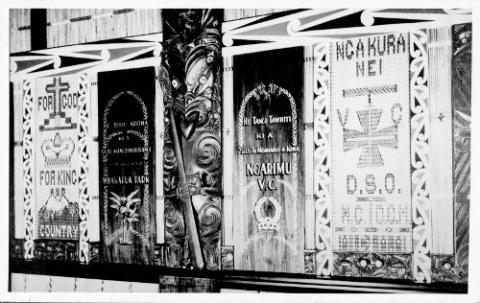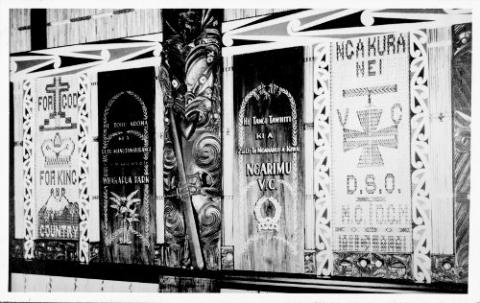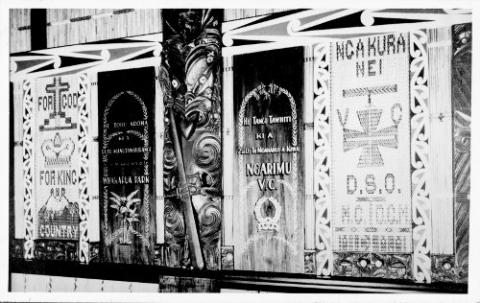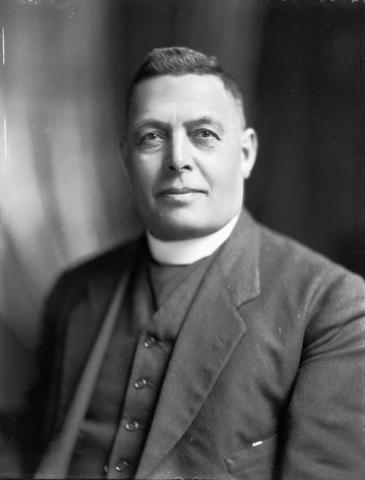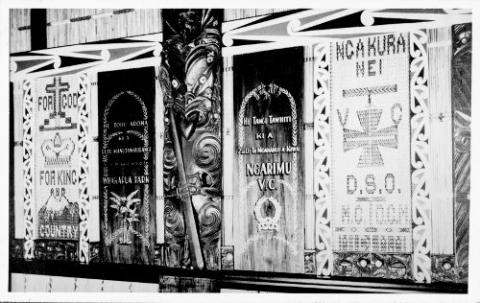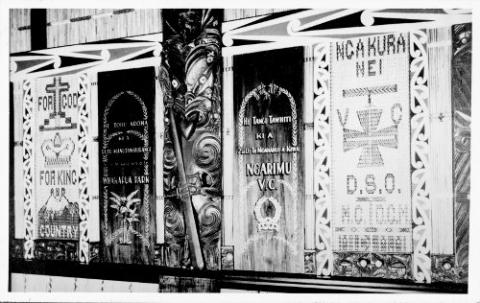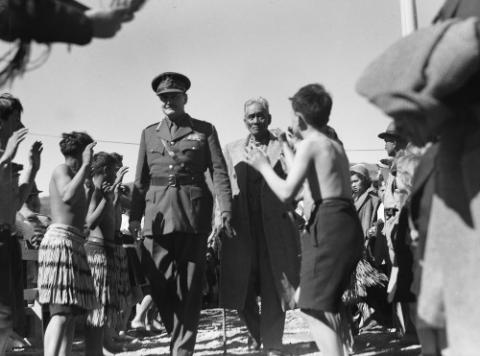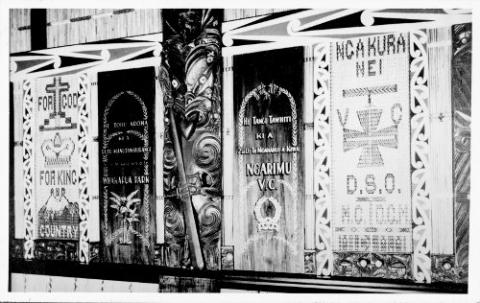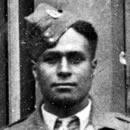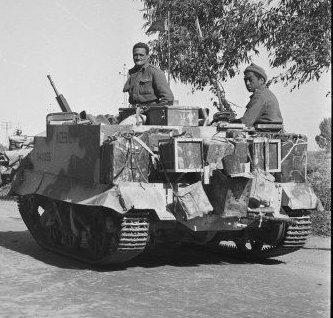<p><strong>An unidentified speaker welcomes dignitaries and addresses the gathering on day two of events at Uepohatu marae in 1947. He speaks in Maori which is then translated into English.</strong></p><p>The marae hosted events held on the 12th and 13th of September that included cultural competitions with local school children and the opening of the Uepohatu War Memorial Hall. The hall was built to commemorate East Coast soldiers who died during the two World Wars.</p><p>A reunion of ex-service people (including members of the Maori Battalion) was also held.</p><p>At the Investiture held on the second day, seventeen decorations were presented to servicemen and women who had served abroad and on the home front.</p><p>The gathering was an important one, attended by thousands including the Prime Minister Peter Fraser, the Leader of the Opposition Sidney Holland and other members of Parliament. Sir Bernard Freyberg, the Governor General opened the hall and unveiled two memorial tablets inside.</p><p> </p>
Puna rauemi
Oro
<p><strong>Sound file</strong> from Ngā Taonga Sound & Vision, ref: <a href="https://www.ngataonga.org.nz/collections/catalogue/catalogue-item?recor…;. Any re-use of this audio is a breach of copyright.</p><p><strong>Image </strong>Nga Taonga a Nga Tama Toa Trust</p>
<p><strong>An unidentified local speaker welcomes dignitaries and entertains the gathering with an expressive speech in Maori. This is translated into English for the Governor General and others in attendance.</strong></p><p>The marae hosted events held on the 12th and 13th of September that included cultural competitions with local school children and the opening of the Uepohatu War Memorial Hall. The hall was built to commemorate East Coast soldiers who died during the two World Wars.</p><p>A reunion of ex-service people (including members of the Maori Battalion) was also held.</p><p>At the Investiture held on the second day, seventeen decorations were presented to servicemen and women who had served abroad and on the home front.</p><p>The gathering was an important one, attended by thousands including the Prime Minister Peter Fraser, the Leader of the Opposition Sidney Holland and other members of Parliament. Sir Bernard Freyberg, the Governor General opened the hall and unveiled two memorial tablets inside.</p>
<p><strong>Sound file</strong> from Ngā Taonga Sound & Vision, ref: <a href="https://www.ngataonga.org.nz/collections/catalogue/catalogue-item?recor…;. Any re-use of this audio is a breach of copyright.</p><p><strong>Image </strong>Nga Taonga a Nga Tama Toa Trust</p>
<p><strong>Governor General Sir Bernard Freyberg addresses the gathering on day two of events at Uepohatu marae in 1947.</strong></p><p>The marae hosted events held on the 12th and 13th of September that included cultural competitions with local school children and the opening of the Uepohatu War Memorial Hall. The hall was built to commemorate East Coast soldiers who died during the two World Wars.</p><p>A reunion of ex-service people (including members of the Maori Battalion) was also held.</p><p>At the Investiture held on the second day, seventeen decorations were presented to servicemen and women who had served abroad and on the home front.</p><p>The gathering was an important one, attended by thousands including the Prime Minister Peter Fraser, the Leader of the Opposition Sidney Holland and other members of Parliament. Sir Bernard Freyberg, the Governor General opened the hall and unveiled two memorial tablets inside.</p>
<p><strong>Sound file</strong> from Ngā Taonga Sound & Vision, ref: <a href="https://www.ngataonga.org.nz/collections/catalogue/catalogue-item?recor…;. Any re-use of this audio is a breach of copyright.</p><p><strong>Image </strong>Porikapa Awatere accompanies Governor-General Sir Bernard Freyberg at the opening of Uepohatu War Memorial Hall on 13 September 1947. <a href="http://natlib.govt.nz/">Alexander Turnbull Library</a>. Ref: A004827.</p>
<p><span><strong>Haka taparahi ‘Te Kiri Ngutu’ performed by locals at Uepohatu marae in 1947. Apirana Ngata exclaims in the audio "koinei te tuturu o te Naati."</strong></span></p><p><span>The marae hosted events held on the 12th and 13th of September that included cultural competitions with local school children, the opening of the Uepohatu War Memorial Hall, a reunion of ex-service people (including members of the Maori Battalion), a concert and the opening of the Uepohatu War Memorial Hall. The hall was built to commemorate East Coast soldiers who died during the two World Wars. </span></p><p><span>At an investiture ceremony held on the second day, seventeen decorations were presented to servicemen and women who had served abroad and on the home front.</span></p><p><span>The gathering was an important one, attended by thousands including the Prime Minister Peter Fraser, the Leader of the Opposition Sidney Holland and other members of Parliament. Sir Bernard Freyberg, the Governor General opened the hall and unveiled two memorial tablets inside.</span></p><h2><span>Transcription</span></h2><p><strong>Kaea:</strong> Torona titaha!</p><p><strong>Apirana Ngata:</strong> E Ngati Porou! Koinei te tuturu o te Nati!</p><p><strong>Kaea:</strong> Haramai tonu ra nga manuhiri i runga i te upoko hau, i te po marangai i te puehutanga mai o te aroha!</p><p><strong><em> <em>Katoa:</em></em></strong> A ha ha! U whakarauiri ki Waiapu. Ka kii te whare ki te manuhiri uhia mai.</p><p>Uhia mai o kanohi ki te rau o te aroha. A ha ha! Hi aue hi!<em><br /> <br /> </em></p><p><strong>Unknown person:</strong> Ka pai boys! Ka pai boys! Kia kaha boys! Kia kaha poi ma! Kia kaha poi ma!</p><p> </p><p><strong>Kaea:</strong> Ponga ra! Ponga ra!</p><p><strong>Katoa:</strong> A ha ha! Ka tataki mai Te Whare o nga Ture!</p><p>Ka whiria te Maori! Ka whiria!</p><p>Ngau nei ona reiti, ngau nei ona take!</p><p>A ha ha! Te taea te ueue! I aue! Hi!</p><p> </p><p><strong>Unknown person:</strong> Ka pai poi ma! Kia kaha poi ma!</p><p> </p><p><strong>Kaea:</strong> Ponga ra! Ponga ra!</p><p><strong>Katoa:</strong> A ha ha! Ka tataki mai Te Whare o nga Ture!</p><p>Ka whiria te Maori! Ka whiria!</p><p>Ngau nei ona reiti, ngau nei ona take!</p><p>A ha ha! Te taea te ueue! I aue! Hi!</p><p> </p><p><strong>Unknown person:</strong> Ka pai poi ma! Ka pai poi ma!</p><p><strong>Apirana Ngata:</strong> Koinei te haka taparahi! Tona tuturu!</p><p> </p><p><strong>Kaea:</strong> Patua te whenua!</p><p><strong>Katoa:</strong> Hei!</p><p><strong>Kaea:</strong> Whakataua i nga ture!</p><p><strong>Katoa:</strong> Hei</p><p><strong>Kaea:</strong> A ha ha!</p><p><strong>Katoa:</strong> Na nga mema ra te kohuru</p><p>Na te Kawana te koheriheri!</p><p>Ka raruraru nga ture!</p><p>Ka raparapa ki te pua toroni! I aue!</p><p> </p><p><strong>Kaea:</strong> Kaore hoki te mate o te whenua e</p><p>Te makere atu ki raro ra!</p><p><strong>Katoa:</strong> A ha ha! Iri tonu mai runga</p><p>O te kiringutu mau mai ai</p><p>Hei tipare taua mo te hoariri!</p><p>A ha ha! I tahuna mai au</p><p>Ki te whakahere toto koa,</p><p>A ki te ngakau o te whenua nei,</p><p>Ki te koura! I aue, taukuri e!</p><p><strong>Kaea:</strong> A ha ha!</p><p><strong>Katoa:</strong> Ko tuhikitia. Ko tuhapainga</p><p>I raro i te whero o te Maori! Hukiti!</p><p>A ha ha! Na te ngutu o te Maori, pohara,</p><p>Kai kutu, ka te weriweri koe i homai ki konei</p><p>E kaore i ai, i haramai tonu koe</p><p>Ki te kai whenua!</p><p>Purari Paka! Kaura mokai! Hei!</p><p><strong>Kaea:</strong> A ha ha!</p><p><strong>Katoa:</strong> Kei puta atu hoki te ihu o te waka</p><p>I nga torouka o Niu Tireni,</p><p>Ka paia pukutia mai e nga uaua</p><p>O te ture a Kawana!</p><p>Te taea te ueue! Au! Au! Aue ha!</p><p><span><br /></span></p>
<p><strong>Sound file</strong> from Ngā Taonga Sound & Vision, ref: <a href="https://www.ngataonga.org.nz/collections/catalogue/catalogue-item?recor…;. Any re-use of this audio is a breach of copyright.</p><p><strong>Image </strong>Nga Taonga a Nga Tama Toa Trust</p>
<p><strong>Led by Apirana Ngata this group perform the entertaining ditty 'Kore au e pai' and the haka 'Ka mate' on day two of events at Uepohatu marae in 1947.</strong></p><p>The marae hosted events held on the 12th and 13th of September that included cultural competitions with local school children and the opening of the Uepohatu War Memorial Hall. The hall was built to commemorate East Coast soldiers who died during the two World Wars.</p><p>A reunion of ex-service people (including members of the Maori Battalion) was also held.</p><p>At the Investiture held on the second day, seventeen decorations were presented to servicemen and women who had served abroad and on the home front.</p><p>The gathering was an important one, attended by thousands including the Prime Minister Peter Fraser, the Leader of the Opposition Sidney Holland and other members of Parliament. Sir Bernard Freyberg, the Governor General opened the hall and unveiled two memorial tablets inside.</p><h2>Transcription</h2><p><strong>AT Ngata:</strong> Tahi, rua, toru, wha!</p><p><strong>Roopu:</strong></p><p>Kore au e pai</p><p>Ki te piki wakena</p><p>Engari motoka</p><p>Ka piki atu au e</p><p> </p><p>Wahine kino koe</p><p>He riri takekore</p><p>Ma reira o mahara</p><p>E raruraru ai e</p><p> </p><p>Kore au e noho</p><p>Hoki ki Pikitia</p><p>Kei kite o haerenga</p><p>Ka hoki tangi aue</p><p> </p><p>Ko pou te marama (ki)</p><p>Runga o Hikurangi</p><p>Kei raro koe hine</p><p>E tangi hotu ana e</p><p> </p><p>Kii mai e hine</p><p>Kahore he aroha</p><p>Kei roto i ahau</p><p>Takawiri ana e</p><p> </p><p>Ko to mai te marino</p><p>Waho o te moana</p><p>Kei roto i ahau</p><p>E ngarungaru ana e</p><p> </p><p>Ma te Hau Tonga ra</p><p>Mau atu te aroha</p><p>Ma te Hau Auru</p><p>E whakahoki mai e</p><p> </p><p>Kore au e pai</p><p>Ki te poi Nati</p><p>Engari Kawana</p><p>Ka wero atu au e! Hi!</p><p> </p><p><strong>Ka Mate Haka</strong></p><p><strong>AT Ngata:</strong> Ka mate, ka mate!</p><p><strong>Roopu:</strong> ka ora! ka ora!</p><p><strong>AT Ngata:</strong> Ka mate! ka mate!</p><p><strong>Roopu:</strong> ka ora! ka ora!</p><p>Tenei te tangata puhuruhuru</p><p>Nana nei i tiki mai whakawhiti te rā</p><p>A, upane! ka upane!</p><p>A, upane, ka upane, whiti te ra!</p>
<p><strong>Sound file</strong> from Ngā Taonga Sound & Vision, ref: <a href="https://www.ngataonga.org.nz/collections/catalogue/catalogue-item?recor…;. Any re-use of this audio is a breach of copyright.</p><p><strong>Image </strong>Nga Taonga a Nga Tama Toa Trust</p>
<p class="MsoNormal" style="margin: 0cm 0cm 8pt;"><strong>Bishop Bennett facilitates the religious service and dedicatory opening of Uepohatu memorial hall on day two of events at Ruatoria in 1947. He notes that the theme is the unification of the two (Maori and Pakeha) races.</strong></p><p>The <acronym title=" open space or courtyard where people gather, generally in front of a main building or meeting house; forum of social life; modern meaning: the complex of buildings surrounding the courtyard and the courtyard itself">marae </acronym><em></em>hosted events held on the 12th and 13th of September that included cultural competitions with local school children and the opening of the Uepohatu War Memorial Hall. The hall was built to commemorate East Coast soldiers who died during the two World Wars. </p><p>A reunion of ex-service people (including members of the Maori Battalion) was also held. </p><p>At the Investiture held on the second day, seventeen decorations were presented to servicemen and women who had served abroad and on the home front.</p><p>The gathering was an important one, attended by thousands including the Prime Minister Peter Fraser, the Leader of the Opposition Sidney Holland and other members of Parliament. Sir Bernard Freyberg, the Governor General opened the hall and unveiled two memorial tablets inside.</p>
<p><strong>Sound file</strong> from Ngā Taonga Sound & Vision, ref: <a href="https://www.ngataonga.org.nz/collections/catalogue/catalogue-item?recor…;. Any re-use of this audio is a breach of copyright.</p><p><strong>Image </strong>Frederick Augustus Bennett. S P Andrew Ltd :Portrait negatives. Ref: 1/1-018699-F. Alexander Turnbull Library, Wellington, New Zealand. <a href="http://natlib.govt.nz/records/22642293">http://natlib.govt.nz/records/2…;
<p><strong>Reading, hymn and prayer as part of the religious service for the opening of Uepohatu memorial hall at Ruatoria in 1947.</strong></p><p>The <acronym title=" open space or courtyard where people gather, generally in front of a main building or meeting house; forum of social life; modern meaning: the complex of buildings surrounding the courtyard and the courtyard itself">marae </acronym><em></em>hosted events held on the 12th and 13th of September that included cultural competitions with local school children and the opening of the Uepohatu War Memorial Hall. The hall was built to commemorate East Coast soldiers who died during the two World Wars. </p><p>A reunion of ex-service people (including members of the Maori Battalion) was also held. </p><p>At the Investiture held on the second day, seventeen decorations were presented to servicemen and women who had served abroad and on the home front.</p><p>The gathering was an important one, attended by thousands including the Prime Minister Peter Fraser, the Leader of the Opposition Sidney Holland and other members of Parliament. Sir Bernard Freyberg, the Governor General opened the hall and unveiled two memorial tablets inside.</p>
<p><strong>Sound file</strong> from Ngā Taonga Sound & Vision, ref: <a href="https://www.ngataonga.org.nz/collections/catalogue/catalogue-item?recor…;. Any re-use of this audio is a breach of copyright.</p><p><strong>Image </strong>Nga Taonga a Nga Tama Toa Trust</p>
<p><strong>Second hymn </strong><strong>as part of the religious service for the opening of Uepohatu memorial hall at Ruatoria in 1947.</strong></p><p>The <acronym title=" open space or courtyard where people gather, generally in front of a main building or meeting house; forum of social life; modern meaning: the complex of buildings surrounding the courtyard and the courtyard itself">marae </acronym><em></em>hosted events held on the 12th and 13th of September that included cultural competitions with local school children and the opening of the Uepohatu War Memorial Hall. The hall was built to commemorate East Coast soldiers who died during the two World Wars. </p><p>A reunion of ex-service people (including members of the Maori Battalion) was also held. </p><p>At the Investiture held on the second day, seventeen decorations were presented to servicemen and women who had served abroad and on the home front.</p><p>The gathering was an important one, attended by thousands including the Prime Minister Peter Fraser, the Leader of the Opposition Sidney Holland and other members of Parliament. Sir Bernard Freyberg, the Governor General opened the hall and unveiled two memorial tablets inside.</p>
<p><strong>Sound file</strong> from Ngā Taonga Sound & Vision, ref: <a href="https://www.ngataonga.org.nz/collections/catalogue/catalogue-item?recor…;. Any re-use of this audio is a breach of copyright.</p><p><strong>Image </strong>Nga Taonga a Nga Tama Toa Trust</p>
<p><strong>The Governor General Sir Bernard Freyberg addresses the gathering and makes the opening dedication of the Uepohatu memorial hall in Ruatoria in 1947.</strong></p><p>The <acronym title=" open space or courtyard where people gather, generally in front of a main building or meeting house; forum of social life; modern meaning: the complex of buildings surrounding the courtyard and the courtyard itself">marae </acronym><em></em>hosted events held on the 12th and 13th of September that included cultural competitions with local school children and the opening of the Uepohatu War Memorial Hall. The hall was built to commemorate East Coast soldiers who died during the two World Wars. </p><p>A reunion of ex-service people (including members of the Maori Battalion) was also held. </p><p>At the Investiture held on the second day, seventeen decorations were presented to servicemen and women who had served abroad and on the home front.</p><p>The gathering was an important one, attended by thousands including the Prime Minister Peter Fraser, the Leader of the Opposition Sidney Holland and other members of Parliament. Sir Bernard Freyberg, the Governor General opened the hall and unveiled two memorial tablets inside.</p>
<p><strong>Sound file</strong> from Ngā Taonga Sound & Vision, ref: <a href="https://www.ngataonga.org.nz/collections/catalogue/catalogue-item?recor…;. Any re-use of this audio is a breach of copyright.</p><p><strong>Image: </strong>Porikapa Awatere accompanies Governor-General Sir Bernard Freyberg at the opening of Uepohatu War Memorial Hall on 13 September 1947. <a href="http://natlib.govt.nz/">Alexander Turnbull Library</a>. Ref: A004827.</p>
<p class="MsoNormal" style="margin: 0cm 0cm 8pt; line-height: normal;"><strong>The hymn 'Au e Ihu' and a dedicatory closing words from Bishop Bennett at the official opening of the Uepohatu memorial hall at Ruatoria in 1947.</strong></p><p>The <acronym title=" open space or courtyard where people gather, generally in front of a main building or meeting house; forum of social life; modern meaning: the complex of buildings surrounding the courtyard and the courtyard itself">marae </acronym><em></em>hosted events held on the 12th and 13th of September that included cultural competitions with local school children and the opening of the Uepohatu War Memorial Hall. The hall was built to commemorate East Coast soldiers who died during the two World Wars. </p><p>A reunion of ex-service people (including members of the Maori Battalion) was also held. </p><p>At the Investiture held on the second day, seventeen decorations were presented to servicemen and women who had served abroad and on the home front.</p><p>The gathering was an important one, attended by thousands including the Prime Minister Peter Fraser, the Leader of the Opposition Sidney Holland and other members of Parliament. Sir Bernard Freyberg, the Governor General opened the hall and unveiled two memorial tablets inside.</p><p><span style="font-size: 12pt; font-family: 'Times New Roman',serif; color: black; mso-fareast-font-family: 'Times New Roman'; mso-fareast-language: EN-NZ;"></span></p>
<p><strong>Sound file</strong> from Ngā Taonga Sound & Vision, ref: <a href="https://www.ngataonga.org.nz/collections/catalogue/catalogue-item?recor…;. Any re-use of this audio is a breach of copyright.</p><p><strong>Image </strong>Nga Taonga a Nga Tama Toa Trust</p>
<p><strong>Charles Bennett speaks at the unveiling of the Ngarimu memorial at Te Poho o Rawiri marae, Gisborne.</strong></p><p><strong>Transcript</strong></p><p><strong>Charles Bennett:</strong> This afternoon, I think it’s most appropriate that we should be unveiling this memorial to Moana nui a kiwa Ngarimu and those of his friends who did not return. Because it was on this very day, the 27th of March 1943 that Ngarimu was killed at Pt 209. I was there, and I remember when the attack was done by C Company the previous evening on this Pt 209 feature, which was heavily defended by the Germans. It was a rocky feature and the Germans were all dug in, into the rock - almost an impregnable position. And I knew we had a very tough job. But the army generals had told us that this feature had to be denied to the enemy because he could look over and see all our movements, we were forming up to break through this Tebaga Gap. Unfortunately for C Company the job of taking this hill feature in broad daylight, I think the attack started at 3 o’clock in the afternoon, frontal attack, uphill, rocky feature, unfortunately C Company and Ngati Porou it was their turn. Now, in the morning, news had trickled down to me, uh, news of the outstanding contribution of Ngarimu. You know before that, both General Freyberg and Brigadier Kippenberger - our superior officers, they said to me you know it’s a pity we haven’t been able to give a Māori soldier the Victoria Cross. See unfortunately right from the very beginning even through Greece and Crete the Māori Battalion fought as a whole unit and performed outstandingly. And if it were possible I would say to, to award a Victoria Cross to a whole unit the Maori Battalion would have got it well before in Crete and Greece. But unfortunately there was not, all the soldiers were good, all the fighting was outstanding but we couldn’t select one. And of course when we heard about Ngarimu’s exploits, word was passed down to me, we knew that here was our chance. And of course our superior officers, the generals were all delighted when they heard about this. In point of fact, we were discussing the award; I was discussing with my officers the award of the Victoria Cross to Ngarimu, this particular morning. Ah it was, it was ah Bully Jackson, I remember well, and Wally Haig who came down from Pt 209 in the morning and said to me “this man is deserving of the Victoria Cross.” And so I started questioning them to get more details and it was just while we were discussing this that the Germans broke through again, on the top, broke through and it was at that moment that Ngarimu was killed. However, it is appropriate that I think at this occasion, we should think about those outstanding soldiers, we should think about Ngarimu and all those others who laid down their lives to protect their country and their people.</p><p><strong>Elder reads inscription:</strong> The inscription on the tablet, written in Maori: <br />“He tohu aroha ki nga tama toa i haere atu i konei ki te pakanga nui o te kotahi mano iwa rau toru tekau ma iwa (1939) ki te kotahi mano iwa rau wha tekau ma rima (1945) tae atu hoki ki nga kaihautu o Te Poho o Rawiri na ratou nei e manaaki”. <br />That’s the Maori way, there are 100 licensed interpreter ‘round about you and they’ll tell you all about it. Thank you very much. </p><p> </p>
<p><strong>Sound file</strong> from Ngā Taonga Sound & Vision, ref: <a href="https://www.ngataonga.org.nz/collections/catalogue/catalogue-item?recor…;. Any re-use of this audio is a breach of copyright.</p><p><strong>Image<br /></strong>Detail of <a href="/node/3910" target="_blank">Officers at Katerini</a><br /><a href="http://timeframes.natlib.govt.nz/">Alexander Turnbull Library</a><br />Reference: DA-14231<br /> Permission of the Alexander Turnbull Library, National Library of New Zealand, Te Puna Mātauranga o Aotearoa, must be obtained before any re-use of this image.<strong><br /></strong></p>
<p> </p><p> </p><p class="MsoNormal"><strong>Te Tohara (Charlie) Mohi grew up in Pakipaki. He embarked for war in 1941 and served with the Maori Bren-carrier platoon. <br /></strong></p><p class="MsoNormal"><strong>In this final recording, Charlie recounts the first time he saw his wife and his warning to his comrades that they were to stay away from her. </strong></p><p class="MsoNormal"><strong>Charlie finishes his interview with an acknowledgement of his comrades who died in the war and those who returned who had also passed on.<br /></strong></p><h2>Transcript</h2><p>Taku taenga mai, i te po i tae mai e au, ka kite au i taku hoa wahine (kata). Ka korero atu au ki aku hoa, “Ka kite koe tera – naku. Kaua koutou, kaua koutou e whakatata atu ki tera, naku tera.”<br />“A, ko wai hoki te ingoa?”<br />“E, kare hoki e mohio, maku e kite e korero atu au.”<br />A, whakaaro pai tonu mai aku hoa kua waihongia taku, taua kotiro nei maku. A, engari ko nga ahua i riro mai ki au, ei, ahua pai tonu. Ka karanga atu au ki te kotiro, “Haere mai, kei te haere koe i taku kainga ki te kai.”<br />“Kare rawa atu, kare e mohio i a koe!”<br />“Kei te pai, haere koe ki te kainga ka mohio koe i a au.”<br /><br />Mai ra ano ki tera wa ki tenei wa, ko taku hoa wahine tenei. Engari ko nga korero, ki au inaianei ko nga mea whakakatakata noa iho. Kei reira ano nga mea kino, engari koira, ki oku whakaaro inaianei kua tapu. Ki nga mate o aku hoa, ki a ratou ma i hingahinga mai i reira. Ka hoki tonu nga whakaaro i etahi wa ki a ratou, engari ko nga mea ngahau kei te mau tonu. Kei te mau tonu era, engari waihongia. No reira, akuni pea me mutu nga korero o tenei. Ko aku hoa, i hoki mai ai matou nga mea o Ngati Porou, te nuinga o ratou kua matemate katoa. Katahi tonu i tera tau ra, etahi o ratou, koinei nga tino hoa i mohio ai au i te wa o te pakanga. A, me waiho i reira, kia ora tatou. </p>
<p><strong>Sound file</strong> from Ngā Taonga Sound & Vision, ref: <a href="https://www.ngataonga.org.nz/collections/catalogue/catalogue-item?recor…;. Any re-use of this audio is a breach of copyright.</p><p><strong>Image<br /></strong>Crop of <a href="/node/3856" target="_blank">full photo</a> - Bren-carrier platoon leads the Maori Battalion into Tripoli, 23 January 1943. Sgt Te Whiu Purei (standing) and Charlie Mohi, seated.<br /><br />Paton, Harold Gear, 1919-2010. Maori Battalion, with anti-tank gunners and a Bren carrier, on an Italian Road leading into Tripoli, during World War 2 - Photograph taken by H Paton. New Zealand. Department of Internal Affairs. War History Branch :Photographs relating to World War 1914-1918, World War 1939-1945, occupation of Japan, Korean War, and Malayan Emergency. Ref: DA-02871-F. Alexander Turnbull Library, Wellington, New Zealand. <a href="https://natlib.govt.nz/records/23069449">https://natlib.govt.nz/records… />See the full photo <a href="/node/3856">here</a>.</p>

